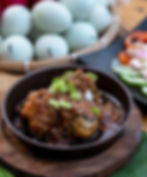Balut: Exploring the Taste, Tradition, and Controversy of the Filipino Delicacy
- KGM Resorts
- Nov 5
- 10 min read
Balut is a fertilized duck egg with a partially developed embryo, famous in the Philippines for its taste and cultural value. This article explores its origins, how it’s made, regional specialties, and the proper way to eat it. Learn why this delicacy remains a Filipino favorite.
Similar dishes can be found in different cultures across Asia, highlighting balut's multicultural roots and significance.
Key Takeaways
Balut is a fertilized duck egg, cherished in Filipino culture as both a snack and a symbol of national identity.
The making of balut is a detailed process that includes incubation for 17-18 days and traditional methods passed down through generations.
While balut has faced controversy regarding animal rights and perceptions of poverty, it remains a beloved culinary tradition in the Philippines and is gaining traction in modern cuisine.

Balut a popular street food in the Philippines photo by JBYBIOSA, CC, via Wikimedia Commons
What is Balut?
Balut is a fertilized duck egg with a partially developed embryo inside—a unique delicacy that might sound exotic to some but is a beloved snack in the Philippines. In Filipino culture, balut egg is more than just food; it’s a symbol of national identity and culinary tradition. The name ‘balut’ translates to ‘wrapped,’ reflecting its traditional incubation method and emphasizing its roots as a popular street food.
Interestingly, while other Southeast Asian countries have similar dishes, such as ‘maodan’ in China, balut stands out due to its deep cultural significance in the Philippines. Balut can also be found in several Southeast Asian countries, including Cambodia and Vietnam, where it is known by localized names and variations. In other countries, similar fertilized eggs are prepared and consumed, but there are differences in incubation time, seasoning, and serving methods that set balut apart from these regional counterparts.
Eating balut involves gently tapping a small opening at the top of the egg to sip the savory broth, then cracking open the rest of the shell to consume the yolk and the embryo. The taste and texture are often compared to chicken eggs, but with a richer flavor. Some people describe the broth as reminiscent of chicken soup, making the experience both familiar and unique. It’s a culinary adventure that offers a unique blend of textures and flavors, challenging yet rewarding for those willing to try it.
The History of Balut
The history of balut is as rich and layered as its flavor. The practice of eating fertilized duck eggs is believed to have originated in China, where it served as a preservation method before the advent of refrigeration. Chinese traders brought balut to the Philippines in 1565 during their settlements near Laguna de Bay in the sixteenth century, and it quickly became integrated into local culinary traditions.
Over the centuries, balut evolved from a foreign delicacy to a distinctly Filipino food, reflecting the unique cultural tapestry of the Philippines. Today, many Filipinos see it not just as a snack but as a symbol of resilience and innovation, embodying the Filipino people spirit in every bite, including balut sa puti. Its tradition and consumption are often passed down through generations, creating familial ties and preserving its cultural significance.
Similar incubated egg delicacies exist in Southeast Asia, such as pong tea khon in Cambodia, which is notable for its specific incubation period and deep cultural roots, highlighting how these foods are woven into local traditions. While balut is celebrated in Filipino culture and folklore, western folklore often views it with curiosity or apprehension, underscoring the contrast between Filipino traditions and Western perceptions.

How Balut is Made
Making balut is a meticulous process that involves:
Selecting the right duck eggs. Most balut makers prefer duck eggs because their shell membrane is stronger than that of chicken eggs, which helps protect the egg during incubation.
Incubating the eggs for about 17 to 18 days until the embryo is partially developed
Wrapping the eggs during incubation, which is the origin of the term ‘balut’
Providing a humid and dark environment for proper egg development
Traditionally, the process for handling fertilized egg involves:
First warming the eggs under the sun.
Transferring the eggs to bamboo baskets.
After the incubation period, the eggs are boiled for 20 to 30 minutes. Boiling is the traditional method of cooking balut, similar to how hard boiled chicken eggs are prepared. The eggs are boiled to achieve the desired texture and taste, making them edible.
Modern producers often use mechanical incubators to enhance efficiency during the incubation process, but they still adhere to practices like turning the incubated eggs to ensure even development and properly incubate them.
An important part of balut making is the candling process, where eggs are illuminated to check the development of the embryo. This ensures that each egg meets the quality standards before it reaches the market, ready to be enjoyed by eager consumers. Balut should be prepared and eaten soon after being boiled to ensure safety and quality.
Regions Known for Balut Production
Balut production is a significant industry in several regions of the Philippines, each contributing its unique touch to this delicacy. These regions are renowned for their balut eggs and the traditional methods used in their preparation, making them key players in the balut industry.
Selling balut is also a key economic activity in these regions, with vendors and markets playing a central role in supporting local economies.
Pateros
Pateros, situated in Metro Manila, is often hailed as the capital of the balut industry in the Philippines. At its peak, balut making represented about 23% of the local industry. Known for its duck-raising practices, Pateros remains a vital hub for balut production, where traditional methods are still widely used.
Laguna
In Laguna, particularly in the town of Victoria, duck farming thrives with a population of approximately 55,000 mallard ducks. The Itik Festival celebrated here underscores the cultural importance of duck farming and balut production in this region.
Duck raisers in Laguna utilize both natural and commercial feeds to ensure high-quality eggs, a practice common among duck farmers at a duck farm.
Central Luzon
Central Luzon is a leader in commercial duck egg production in the Philippines. The region’s numerous farms significantly contribute to both the local and national economy, underscoring its importance in the balut industry.
Western Visayas
Western Visayas is notable for its 1.36 million backyard ducks, the highest concentration of small-scale duck farms in the country. This region supports local economies and preserves traditional farming practices, playing a vital role in the balut industry.
Mindanao
Mindanao has seen a significant surge in demand for duck eggs, driven by the popularity of balut. This growth has established balut production as an integral part of local cuisine and culture in Mindanao.
Chinese trading practices and local consumption patterns have further bolstered the balut makers industry here.

Economic Impact of the Balut Industry
The balut industry is a cornerstone of the Philippine economy and a deep-seated part of its culture. The journey from fertilized duck eggs to a beloved street food snack provides vital livelihoods for thousands and generates billions in annual revenue.
Here are the key highlights of the industry's role:
A Primary Source of Livelihood: Duck farming and balut production are a way of life for many, particularly in rural communities. The industry provides steady employment for thousands of Filipinos, from those who raise mallard ducks to expert balut makers and urban street vendors who sell the finished product.
Significant Economic Contribution: The entire duck industry, including balut production, contributes billions of pesos in annual revenue. This economic impact supports a thriving network of distributors, retailers, and small and medium-sized enterprises (SMEs) involved in processing, packaging, and sales.
A Valued Skill and Tradition: Balut makers utilize time-honored techniques for the delicate incubation process, which can last up to 21 days. This expertise ensures the quality and signature taste of the product, which is highly valued in the community and critical to the industry's success.
Innovation and Market Expansion: Entrepreneurship is flourishing within the industry, with SMEs introducing modern takes on the traditional snack, such as cooked balut dishes, balut flakes, and other appetizers. These innovations help the industry remain competitive and broaden its appeal.
Food Security and Nutrition: Beyond its economic function, the balut industry plays a key role in Filipino food security. Balut is an affordable source of protein, vitamins, and minerals, making it an important part of the Filipino diet, especially in areas where other protein sources may be less accessible.
Cultural Preservation: The industry helps preserve a unique aspect of Filipino culture and cuisine. Despite challenges such as fluctuating demand, the industry remains resilient, ensuring that the tradition of eating balut continues to be a vital part of the nation's cultural and culinary landscape for years to come.
Traditional Methods of Eating Balut a Filipino Delicacy
Eating balut is a ritual often enjoyed as a late-night snack from street vendors. The process typically begins with sipping the flavorful liquid from the shell, a warm and savory introduction to the flavors within. Cooked balut soup is best eaten warm, which enhances its texture and taste, so be sure to chew it well. Edible balut is a unique experience that many have tasted, especially when paired with hot vit lon.
Salt, vinegar, chili, and soy sauce commonly accompany balut, adding a tangy and spicy contrast to the rich, slightly gamey flavor of the egg and embryo. While the egg yolk is a creamy delight, many prefer to avoid the egg white part, known as the rock, due to its tough and unusual texture, which some people find challenging. Some even choose to eat balut without looking at it, savoring the experience without the visual shock.

Balut in Modern Cuisine
Balut has moved beyond street food to find a place in modern cuisine. In upscale restaurants, it often appears as a cooked appetizer or in dishes like adobo style or omelets. Balut can also be incorporated into baked or fried dishes, such as baked balut appetizers or fried balut street snacks, which are gaining popularity in contemporary Filipino cuisine.
This gourmet twist has introduced balut to a new audience, showcasing its versatility and rich flavor profile. In New York, Filipino restaurant Maharlika hosts an annual balut eating contest, featuring balut as a central dish and celebrating its cultural roots.
In North America, balut is available in Asian markets, though it remains an exotic and less common item. Meanwhile, in Vietnam, balut is served with lime juice and ground pepper, adding a refreshing zest to the dish. These variations show how balut can be adapted to different culinary traditions while retaining its essence.
The influence of Chinese culinary traditions is also evident, with their own version of balut, known as maodan. This cultural exchange enriches the culinary landscape, offering diverse ways to enjoy this unique delicacy.
Health Benefits and Nutritional Value
Balut is both a flavorful treat and a nutritional powerhouse. It provides high-quality protein and essential amino acids crucial for muscle growth and repair. The egg also contains significant amounts of iron, calcium, and vitamin A, which are vital for overall health. Additionally, balut is considered one of the unique foods that offer these benefits.
Balut offers several health benefits:
High in omega-3 fatty acids, benefiting cardiovascular health and reducing inflammation
Contains choline, which supports brain health and liver function
Includes various vitamins that enhance immune function and energy metabolism
For optimal freshness and food safety, balut has a limited shelf life and is best consumed soon after cooking.
Controversies Surrounding Balut
Balut is not without controversy. Animal rights advocates criticize it for being inhumane due to the consumption of developing embryos, viewing it as cruelty against a bird and sparking heated debates.
Cultural perceptions of balut vary widely. While some see it as a cherished tradition that should be preserved, others, particularly in Western cultures, view it as an exotic and taboo food. Media portrayals, especially in reality TV shows, often exaggerate the shock factor, influencing public opinion negatively.
In the Philippines, younger generations sometimes associate balut with poverty, affecting its popularity. Despite these controversies, many argue that eating balut is a cultural practice that deserves respect and understanding.

Balut in Pop Culture
Balut has made its way into pop culture, often featured in reality television shows like ‘Fear Factor’. These shows typically present balut in an exaggerated and often negative light, focusing on contestants’ disgust and shaping public perception. This portrayal has contributed to the view of balut as a bizarre and unappealing food. It is also a popular feature in eating challenges on shows like Survivor, further cementing its reputation as a daring culinary experience.
Despite this, balut remains popular in the Philippines, celebrated for its unique flavor and cultural significance. Its media appearances have added to its mystique, inviting both curiosity and skepticism worldwide.
Summary
Balut is more than just a quirky food challenge; it’s a window into the rich culinary and cultural heritage of the Philippines. From its historical origins to its modern-day adaptations, balut embodies the spirit of Filipino innovation and tradition. Whether enjoyed as a street food or a gourmet dish, it offers a unique culinary experience that is both nutritious and flavorful.
The controversies surrounding balut highlight the complex interplay between tradition and modern values. While it may not be for everyone, understanding and respecting this delicacy can foster greater appreciation for the diverse ways in which cultures celebrate their heritage through food. So next time you encounter balut, consider giving it a try—you might just discover a new favorite.
Frequently Asked Questions
What exactly is balut?
Balut is basically a fertilized duck egg with a partially developed embryo, and it’s a popular street food in the Philippines. It's definitely an experience if you're up for trying something new!
How is balut traditionally eaten?
Balut is best enjoyed warm—sip the broth from the shell first, then dig into the yolk and embryo, adding a sprinkle of salt or a splash of vinegar for extra flavor.
What are the health benefits of eating balut?
Eating balut is a great way to boost your protein intake and get essential nutrients like iron, calcium, and omega-3 fatty acids. It’s not just a tasty treat; it packs a serious nutritional punch!
Why is balut controversial?
Balut gets a lot of heat because people debate the ethics of eating developing embryos, plus it stirs up mixed feelings across cultures and media. It's definitely not for everyone!
Where can I find balut outside the Philippines?
You can find balut at Asian markets in North America, and some upscale restaurants offer it as a gourmet dish. It's worth checking out those spots if you're craving it!












